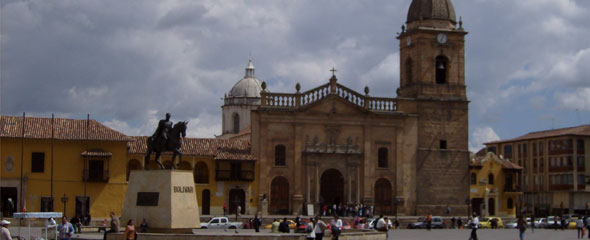
The nice thing about Bogota is that its so close to so many other places it is very easy to leave. One of the places that can be reached in three hours is Tunja.
From Bogota you can get on a bus to this city anywhere between the main Terminal and the Portal Norte of the Transmilenio. Two hours after you leave the city you will find yourself in the chilly capital of Boyaca.
In Tunja the people have the look of peasants, Boyacense peasants. They probably have as much or more colonial architecture as Villa de Leiva, it is just scattered about and more variously colored. Tunja is dirty, with narrow and authentic-feeling streets. I love it because it doesn’t feel fake: it’s the way they would live if they were left alone. You can find hotels to stay at for 30,000 pesos in Tunja if you wander down the streets leading off of the main plaza, away from the cathedral.
They drink a lot of coffee there and consume great quantities of sugar; never have I seen bigger sugar bowls on the tables. At five in the afternoon all the coffee places are packed. At one place the guy cuts up small oranges about the size of lemons and puts a wedge on the saucer; I tried my tinto that way and it was good. I inquired of him whether it was a Boyacense custom and he grew a bit abashed, and from the confused reply I gathered he had gone so far as to commit an original act. He was also so confused he handed me back my payment with the change, as if by catching him out at having his own little flair, his way of setting his coffee shop apart from the other ten on that alley, I had caught him doing something worse than those traditional and respected occupations of pirating movies or running a brothel. I made sure he kept his money, and I hope he is still putting small wedges of orange on the tinto saucers to the amazement of all Tunja.
Tunja is hard because of the hills, and because of the dust and narrow sidewalks. But you don’t see fancy rich people there or their sterile gathering places; it is all small town: small town lawyers, small town waiters (the one guy never addressed customers without holding a tray, usually empty and with a large towel covering it; and how he flourished the plate bearing on it the rice, fries, lentils, salad and meat of the corrientazo), small town merchants and politicians, peasant relatives of the small town lawyers in town with round eyes, ruanas, the hats, descendants of the Muiscas and collectivos which to a practiced Bogota eye looked almost bankruptly empty. You also see many people with chapped cheeks there, because it is high and windy, and cooler than Bogota.
Tunja is dingy, but unpretentious. While in whitewashed Villa de Leiva I saw one painting that I liked, that seemed to have the power of art to suggest something. It was an abstract panting, and the most that can be said for it was that it was vaguely geometrical. It suggested a city with its lines, its yellow portions like the light of buildings, its greys and black lines with red paint randomly dripped. And it was in fact supposed to suggest a city, because the title was Metropolis. It made me reflect that a city is an abstraction, and Bogota is such a place if not entirely. Villa de Leiva is something else, not on the same scale as Bogota, not dominated by traffic like Bogota is, quiet and slow, but in a way, fake, an artificial city – though a pleasing artifice – maintained not for its inhabitants so much as for its visitors.

